|
|
Post by bixaorellana on Apr 18, 2010 8:14:08 GMT
 After leaving the cochineal farm Thursday afternoon, I walked a little way south along the highway in order to visit the town of San Bartolo Coyotepec ~ 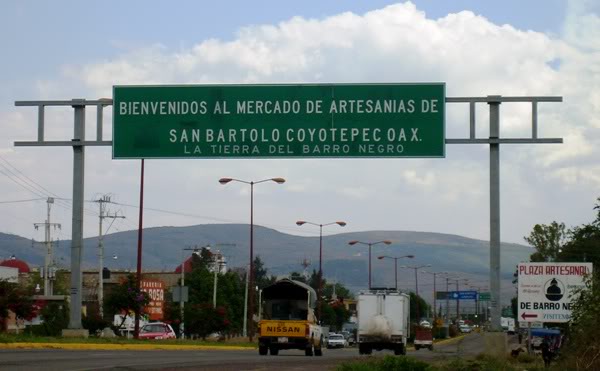 San Bartolo is home to the state folk art museum, but its longtime claim to renown is the ornamental black pottery developed and produced here. The workshop of Doña Rosa was my objective. She died in 1980, but her legacy lives on in a huge store and in the pottery demonstrations of her son Valente. San Bartolo is a rustic, little town. Even though it's right on the highway, there are few businesses. It's very quiet and I didn't see many people, but passed timeless buildings such as this one ~ 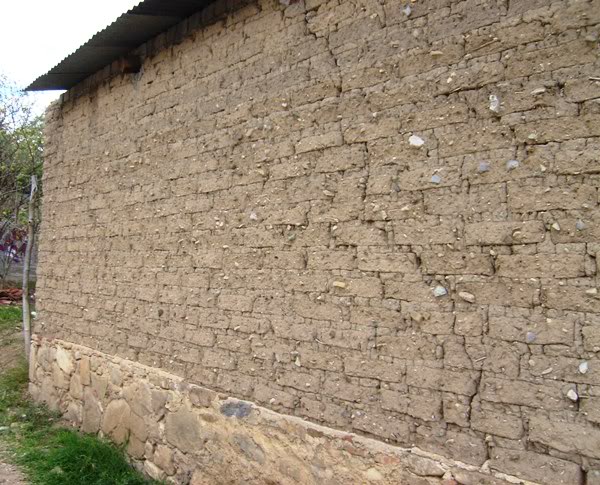 I did have the good luck to pass a lady wheeling a barrow full of unbaked clay items into her yard. She allowed me to take this picture, and explained that this is the color of the local clay before firing ~ 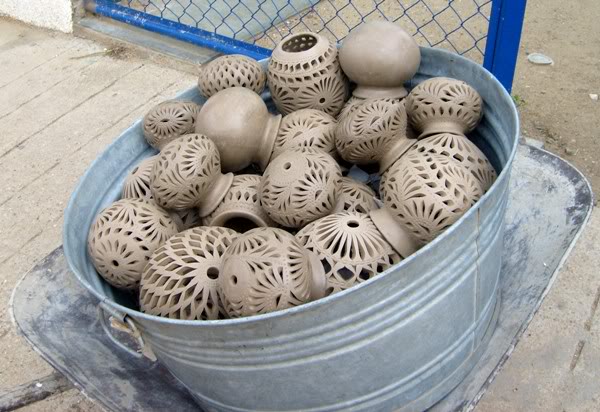 There was no one around at Doña Rosa's either, except for a kid packing stuff. The lovely open-air shop is built around a huge grassy patio and displays photos of Doña Rosa and her family on the walls, including one wall of celebrities who've visited, such as Nelson Rockefeller, Jimmy Carter, and Luis Miguel ~ |
|
|
|
Post by bixaorellana on Apr 18, 2010 8:14:41 GMT
|
|
|
|
Post by bixaorellana on Apr 18, 2010 8:15:22 GMT
It wasn't until I was ready to leave that the kid wrapping pottery said, "Don't you want to see the demonstration?" He then took me to a large room adjoining the patio, where the demonstration was already under way in front of a small group and their tour guide. I entered just as one of them got up to get a picture with the maestro. 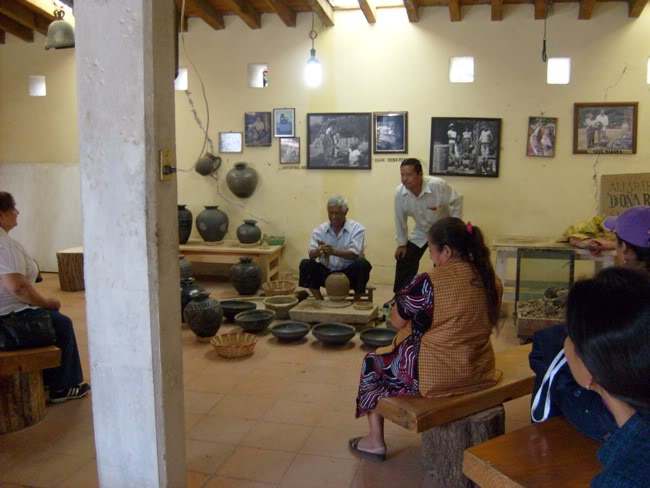 Note the wheel Don Valente is using. It's nothing more than two clay saucers back to back. I saw this demonstration about ten years ago, when it was more elaborate. He took pains to assure us that he was just demonstrating the technique, and that any real work would look much better. He explained that the original San Bartolo pottery was used to hold liquids, not for cooking, as it would shatter in the fire. You can see some of the non-shiny original pottery on the table behind him. He struck some of the pieces forcefully with a stick and produced clear, bell-like tones. At the end of the demonstration, he went back and forth with the stick on the shallow vessels you see in front of him, creating a lovely series of tones. In the last two photos below, you see him wielding the polished quartz on a pot that has dried for two weeks. This is what burnishes the clay to give the characteristic San Bartolo sheen to the pieces when they're fired to a final blackness.  In the video, Don Valente is explaining the piece of leather he's holding. He says that it can only come from a particular part of the bull -- I believe the front of the neck -- or it won't serve to polish the clay. (sound needs turning up quite a bit)Please re-visit this thread later, as I'll add some scenes from the town, plus a great many pictures from the beautiful museum. |
|
|
|
Post by Deleted on Apr 18, 2010 16:25:20 GMT
Those items are really lovely -- they almost make me regret that in my small urban setting, I have no use and no space for pottery!  |
|
|
|
Post by lagatta on Apr 18, 2010 23:33:27 GMT
Lovely. I'd love to see what is left of the utilitarian pottery too.
Just reading through some of the links in bixa's posts - it speaks of how to dress as a tourist in Oaxaca (city and state). Bixa, I've seen tourists in beach wear in Venice... I notice them wearing the lovely guayabera as something men can properly wear as tropical formal dress - are any of those made in your State?
|
|
|
|
Post by bixaorellana on Apr 19, 2010 4:47:21 GMT
Kerouac, I only have one piece of the black pottery. It's small statuette of the Virgin of Solitude which happened to appeal to me. She used to live on top of my cpu, but has a place in the bookcase at the moment.
I don't know if this happens with other folk art in other places, but sometimes seeing such oceans of the stuff, as in the pictures above, can kill any desire to own some of it.
LaGatta, some people at Don Valente's demonstration were asking about the original, utilitarian pottery. He had to think, but said he thought there were a few pitchers available.
Guayaberas are sold here and you see men wearing them, but they are produced in the Yucatán peninsula. They're also popular in the hot areas of Veracruz and coastal Oaxaca.
|
|
|
|
Post by bixaorellana on Apr 19, 2010 4:47:43 GMT
Leaving the workshop, I walked toward the church, marveling at the beautiful skies. From the side, the great age and traditional design of the church can be seen, but from the front, it rather resembles something from a toy village. I have always been charmed by the black pots atop the brick supports of the church fence. I was disappointed I couldn't go inside, as the gate was locked. 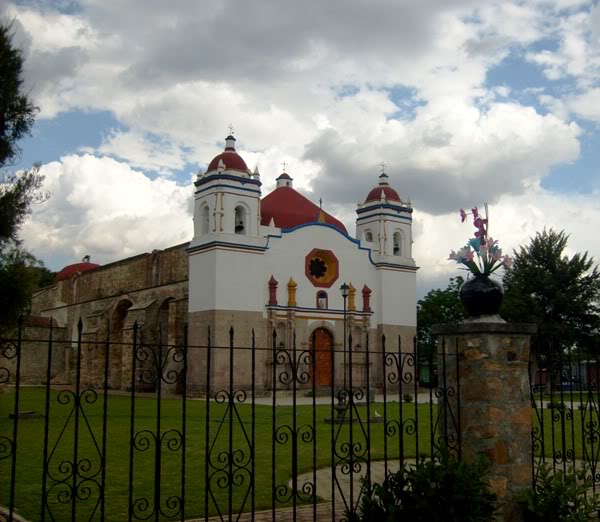 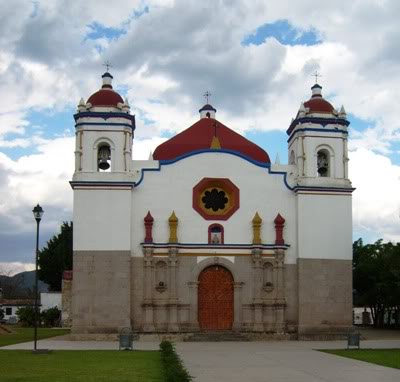 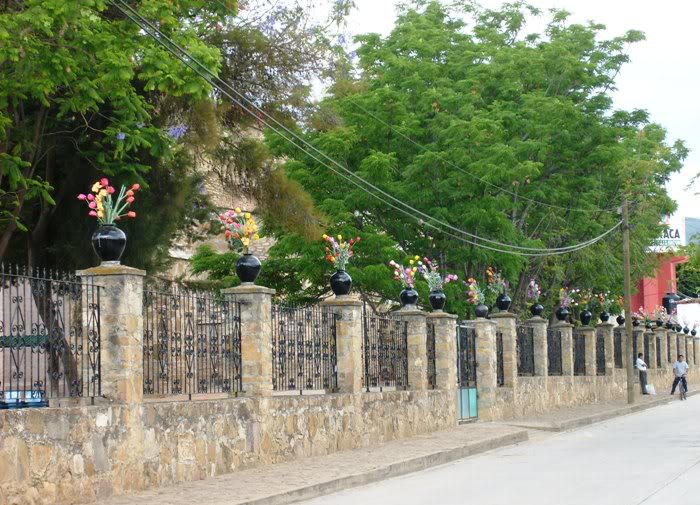 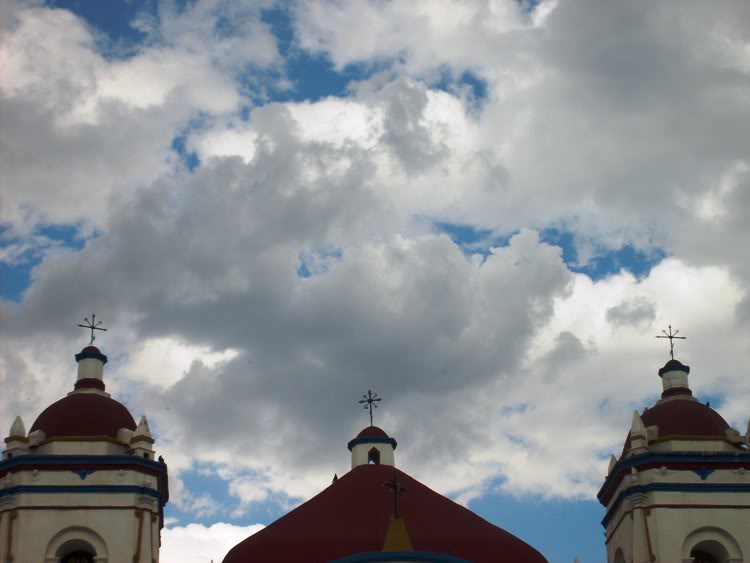 |
|
|
|
Post by bixaorellana on Apr 19, 2010 4:48:18 GMT
Crossing the highway, I went under a long covered walk facing the town square. It's perfectly appropriate in that traditional spot, but is the front of the startlingly modern and exquisitely designed State Museum of Oaxacan Folk Art. 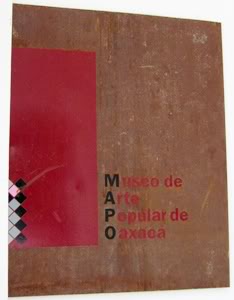 This beauty of a bygone age gazes through the front windows, along with her little dog. 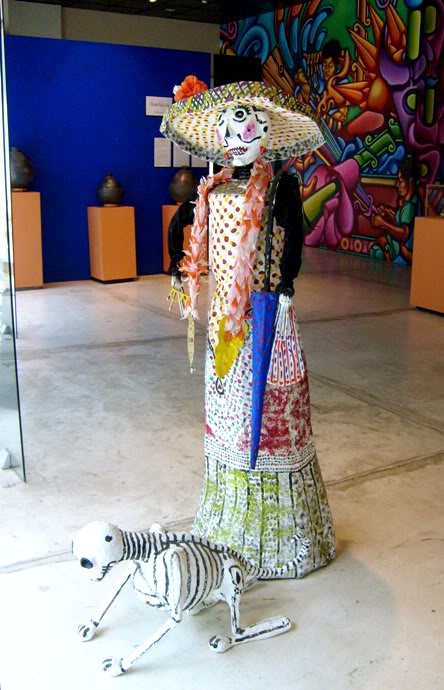 The image of death as an elegant woman -- a catrina -- in skeletal form was created by the illustrator and engravor Posada in 1913. The figure was a political statement on the Mexican upper classes of the times. Although it faded from the public consciousness, it was later revived by the French artist Jean Charlot and became an enduring and popular representation of Death. A myriad of variations on this image can be found in art all over Mexico. Behind La Catrina is the gallery dedicated to the black pottery of San Bartolo and its various artistic manifestations. 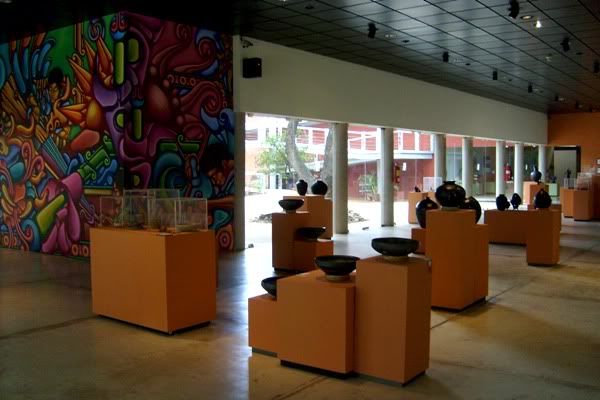 Taking pride of place on the back wall of the gallery is this dramatic sculpture by renowned artist and museum director, Carlomagno Pedro Martínez. 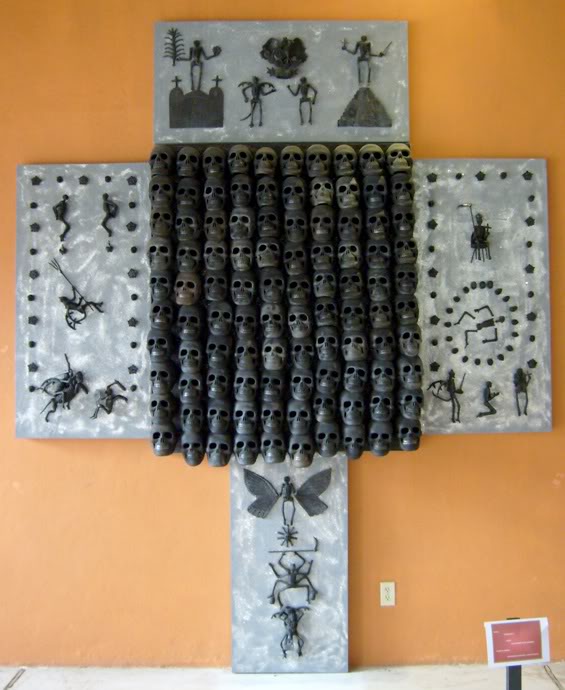 How appropriate to see these faces on the wall, gazing out over a collection of pieces now recognized as art. This family was probably photographed in the 1950s, in the formative years of San Bartolo decorative pottery. 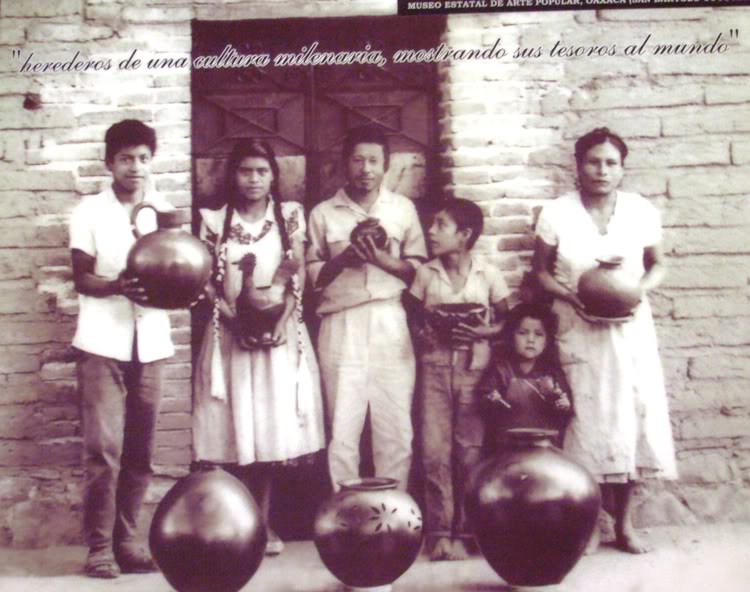 |
|
|
|
Post by bixaorellana on Apr 19, 2010 4:49:01 GMT
I fell completely in love with the figures by Magdalena Pedro Martínez, a doctor, ceramicist, and sister of the museum director.
It was extremely difficult to capture both the deep blackness of the figures and the delicate detail of face and clothing. This figure deserves to be seen from more than one angle.
This piece is exceptional in that it depicts the Virgin of Guadalupe dressed in the traditional costume of one of the regions of Oaxaca.
The figure in profile below depicts yet another regional costume. The figure facing out is Our Lady of Solitude, the patron of the city of Oaxaca.
This was probably my favorite piece by Madgalena Pedro. She is shown wearing the huipil of Huautla de Jiménez, main city of the Mazateca region of Oaxaca. The photo on the left shows it as naturally as my camera was able to achieve.
I brightened the photo on the right in order to show the detail and wonderful rendering of expression and gesture.
I feel badly that I neglected to get the artist's name who created this lively and suspenseful piece using a different treatment of the black clay. |
|
|
|
Post by bixaorellana on Apr 19, 2010 4:49:36 GMT
These paper figures were rather abandoned toward the back of the gallery. They are examples of "toritos" -- frames of reed covered with paper to depict bulls or turkeys or baskets of flowers or any number of other animals or items. They are then loaded, and I mean loaded, with fireworks so people can take turns dancing with the figures as the lit fireworks explode. 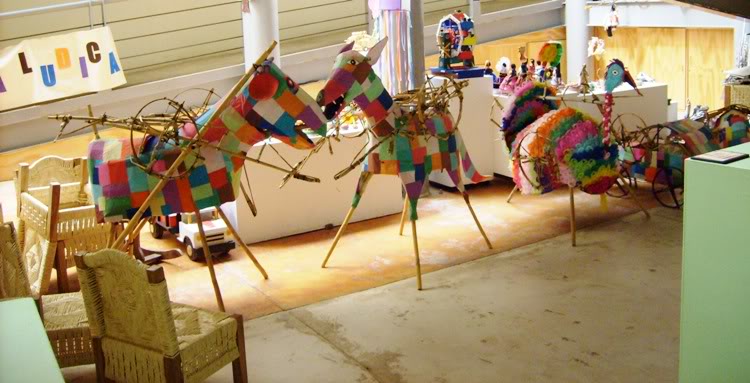 The toritos, the child-sized furniture, and the toys were kept company by these vehicles wrought in tin. There was also a sputnik, a train engine and some others, either flying from the ceiling, or running along the sand track on the floor  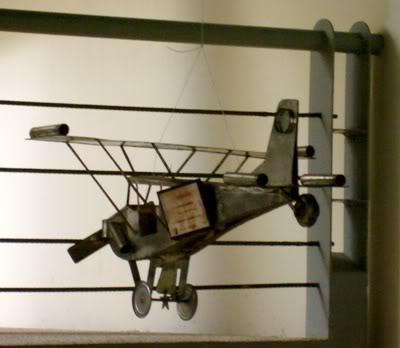 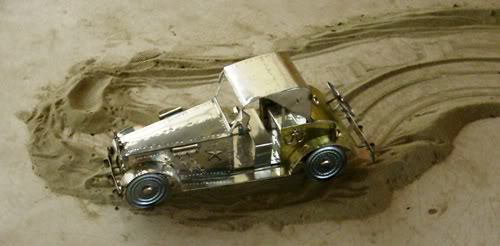 Playfulness abounds in Mexican art, and is frequently mixed with religious themes. That's illustrated here by these two figures, the meaning of which remains mysterious to me, although that doesn't lessen their delight. Each depicts a cow contentedly chewing some grass and displaying an image of the Virgin of Guadalupe in her stomach to a bemused dog. Sorry one is so dark -- I had to take it facing directly toward the bright window. 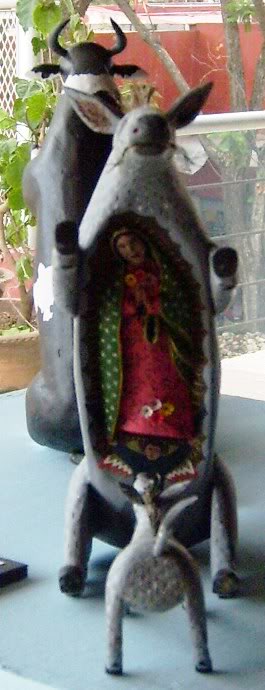 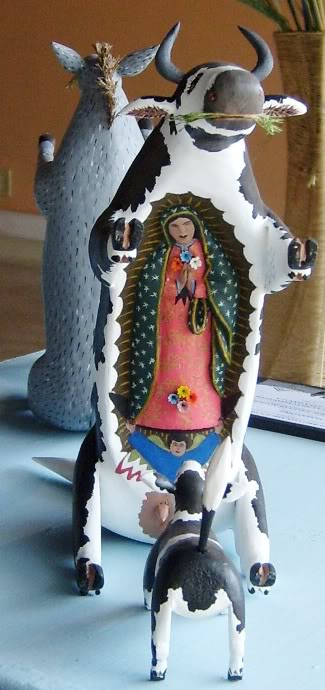 Perhaps somewhat more reverent is this figure by Lorenzo Demetrio García Aguilar, a member of the renowned Aguilar family of Ocotlán de Morelos. It is of the Virgin of Guadalupe with God the Father over one shoulder, God the Son over the other, and the Holy Spirit in the form of a dove on her bosom. Below her hands, cherubs hold the cape of Juan Diego with her image and the miraculous roses. Below that is another angel, then Juan Diego. 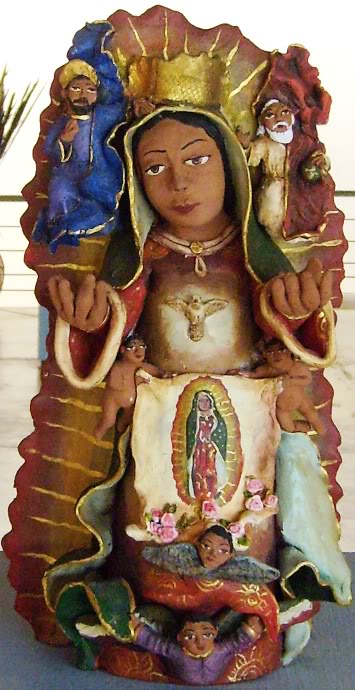 Not to be outdone in elaborate depiction of the Blessed Virgin, this piece showing Our Lady of Solitude, by Leopoldo Garcia Aguilar of Ocotlán, has four other manifestations of the Virgin on her cape -- that of San Juan del Lago, of Juquila, the Immaculate Conception, and Guadalupe. Beneath the all-seeing eye of the heavens and the tree of life complete with serpent, Adam and Eve do their best to enjoy earthly delights, along with the angelic couples coupling on either side of whom I assume to be God the Father. 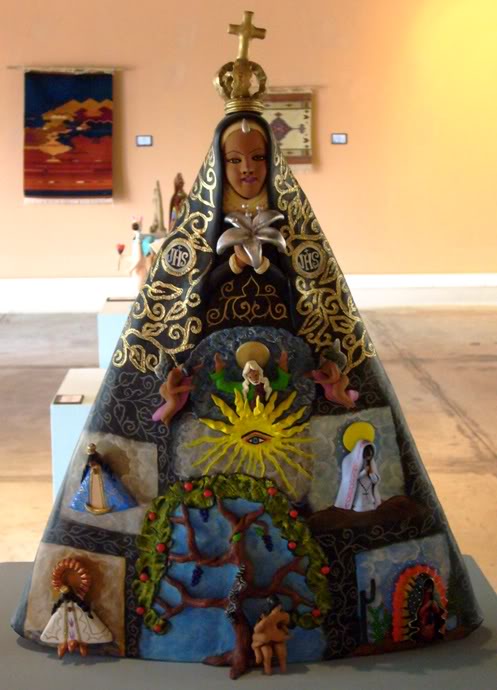 |
|
|
|
Post by bixaorellana on Apr 19, 2010 4:51:46 GMT
I hope you all are enjoying this visit to the town and museum. Also, I hope there's enough here to hold your interest while I prepare the rest of my material for posting.  I'll try to answer any questions people may have. |
|
|
|
Post by spindrift on Apr 19, 2010 8:46:07 GMT
Having viewed your pictures I am breathless with wonder. It seems, then, that an entire family would learn the art and each generation would carry it on. I am trying to understand how the dry clay product can be burnished to such a black glaze just by the application of 'polished quartz'...do you mean that the artist is rubbing a piece of quartz stone on the pot that has been applied to the bullskin polisher or has the quartz been pulverized? My son was a talented potter when he was at school and I know that excellent glazes are not easy to achieve.
For how long are these pots fired in the oven and what sort of oven is it? it is a natural fire oven or an electric one? We used to have an electric one; it was huge and immovable.
I've been looking at your first pictures of what looks like clay door handles and each one is perfectly made. What instrument is used to sculpt the lattice work in the clay?
Is it the application of the quartz glaze that renders the fired pots so sturdy and unbreakable?
Thank you Bixa for this wonderful thread.
|
|
|
|
Post by bixaorellana on Apr 19, 2010 15:53:03 GMT
Spindrift, thank you for your interest and encouragement. I should have put a pen or something in the photos to show size. The "door handles" are at least 4" tall. The smallest ones are larger than a glass paperweight. The rounded or cone-shaped items are used as chimneys atop candles.
Don Valente used the word "polishing" for what he did with the wet piece of leather. However, it was more a matter of smoothing and finishing off the lip of the jar as he formed the wet clay.
The burnishing was done on a pot that had been allowed to dry for two weeks. We saw the dull pot, then he rapidly passed the quartz over it several times. Then the pot was passed around so we could feel it. Indeed, the burnished area was hard, shiny, and smooth.
The instruments used for sculpting are the very primitive tools you see in front of Don Valente -- tubes of reed and broken pieces of gourd!
Here is a 3-part set of videos from the web which show the entire demonstration:
1.
2.
3.
The kilns are pits in the ground. Look at my first picture in Reply #2 above, please. On the wall behind Don Valente is a photo of him as a young man. He's standing down inside the pit as his mother passes him the pots to be fired.
Now look at this wonderful video of Doña Rosa at work, along with Don Valente packing the kiln.
And here is a good, quick close-up look at the kiln:
|
|
|
|
Post by joanne28 on Apr 19, 2010 19:47:42 GMT
This is absolutely wonderful, Bixa. Thank you for posting such beautiful pictures.
|
|
|
|
Post by Deleted on Apr 19, 2010 19:59:16 GMT
Oh shit, I would definitely wear a helmet before carrying those fireworks around!  I don't have enough hair left as it is. The photos are fantastic, bixaorellana, from the beautiful simplicity of the church façade to the lovely statues. As much as I am not religious, I have great respect and admiration for religious art. |
|
|
|
Post by bixaorellana on Apr 19, 2010 21:05:40 GMT
What a lovely thing to say, Joanne ~~ thank you!
I think religious art is fascinating as, depending on the freedom of the artist, what is depicted may be worlds away from what a religion officially espouses. I'm thinking of early Renaissance paintings of the Annunciation, for instance. Why did it capture the imagination of so many artists, and why do those paintings seem to glow with true inspiration?
Mexican religious art is particularly interesting because of the history of the country. Christianity was forced upon the inhabitants, often violently. There is certainly ample evidence that it "took" with many people, who don't deviate from dogma. However, the underlying pride in heritage and remnants of indigenous religion give an exuberance and imaginative verve to "religious" art here that is often just plain fun. The town of Ocumicho in Michoacán (Don Cuevas' state) is known for its bright, naive clay figures. One of the artists there specializes in Last Suppers ...... Last Suppers featuring devils, or mermaids, or ladies of the evening instead of the Da Vinci-like tableau we'd expect.
|
|
|
|
Post by gertie on Apr 19, 2010 23:38:20 GMT
Oh my wonderful!  |
|
|
|
Post by fumobici on Apr 20, 2010 2:28:41 GMT
Beautiful and evocative set of photos! I must venture South well past the horrible border towns some day.
|
|
|
|
Post by hwinpp on Apr 20, 2010 2:45:11 GMT
Funny how simple country folk make appealing objects like these that seem attractive to such a broad range of people (like on this board).
Nice pics, Bixa.
|
|
|
|
Post by bixaorellana on Apr 20, 2010 3:14:48 GMT
Thanks, Gertie! Stay tuned, please ~~ there's more to come. Thanks so much, Fumobici -- nice compliment! I think you'd love Mexico. One of the great things about it is that there's still real variety from place to place. And just think of all the doors! ;D 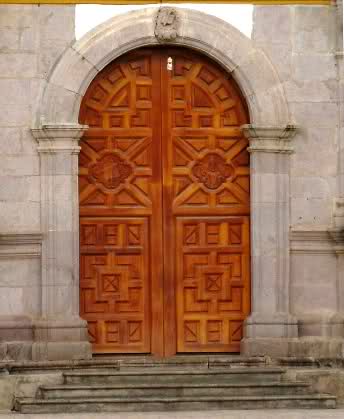 Thank you, HW. One thing I really liked about this museum is how the more naive stuff is mixed in with what I guess would be outgrowths of the more "folk" forms of the art. Maybe the broad range of appeal of these pieces is because of the sincerity with which they're created. |
|
|
|
Post by bixaorellana on Apr 20, 2010 4:56:15 GMT
I found the museum building quite beautiful and pleasing, although it could certainly use some landscaping. This view is looking out across the patio from the big front gallery toward the bathrooms, with a second large display room on the right. The ramp leads upstairs to a third one. 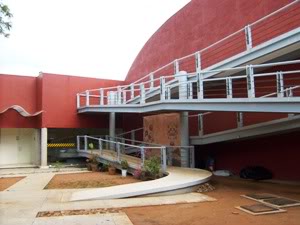 The museum was built on the site of the primary school (donated by a philantropist in 1905). It was designed by the architect Danilia Calderón and constructed by the Melgosa firm. It is 1400 square meters in size. 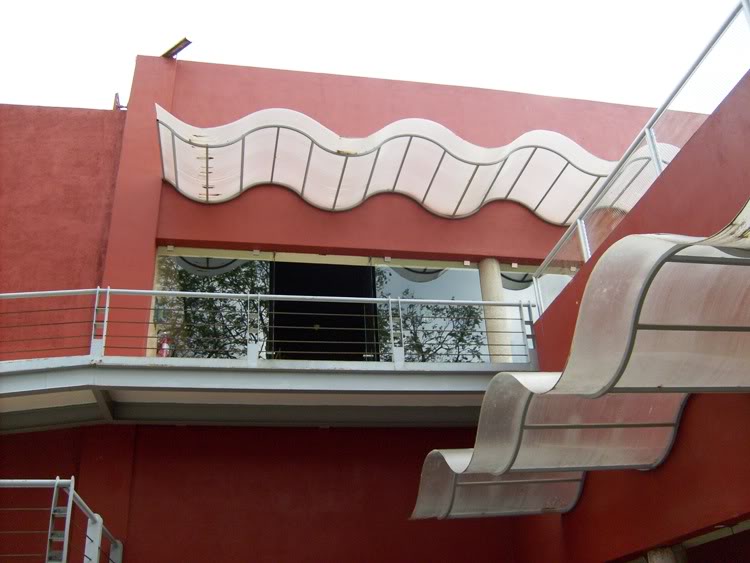 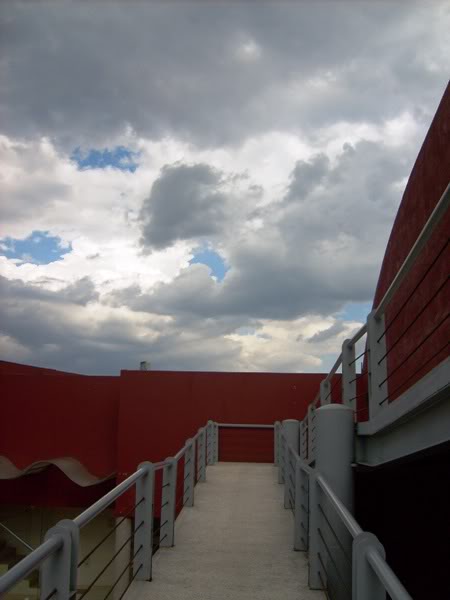 Well, let's go upstairs and see what there is to see. I should add that the reason these pictures are so empty is because there were no other people around -- not visitors, not employees. When I arrived, I was greeted by about four people who worked there, who were sitting together chatting. They were very gracious, took my fee, gave me a brochure, then let me go wander around. Fine by me! One thing that is very surprising is that nothing is protected. It does make for more detailed and intimate viewing, as one can walk all around each piece and really examine it. It's a mixed group up here, with works by some of Oaxaca's best-known artists in a variety of media. The mermaids are from Atzompa. Atzompa is another pottery village that I would say produces the vast majority of utilitarian items -- bowls, cooking pots, etc. -- for the entire valley. Everything from humble clay bowls at street-side eateries to giant vessels for making moles to lovely green pots for chocolate comes from Atzompa. 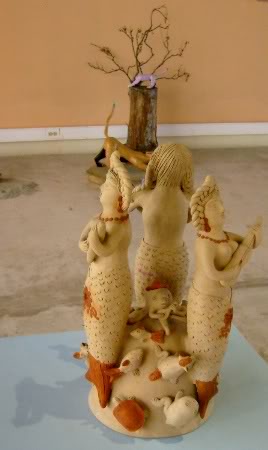 This weaving is by Arnulfo Mendoza of Teotitlán del Valle. It's silk, with real gold woven into it. This is quite a small piece, approximately 2' x 2'. 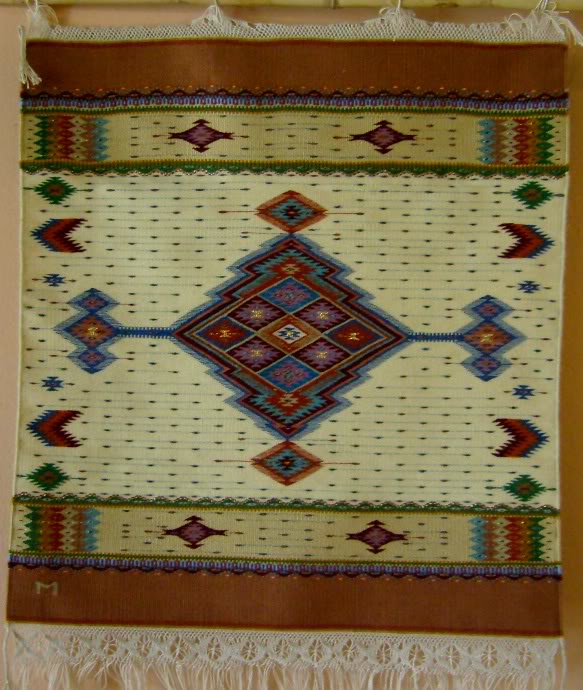 Another of Mendoza's. It employs many of the classic designs used in these rugs. 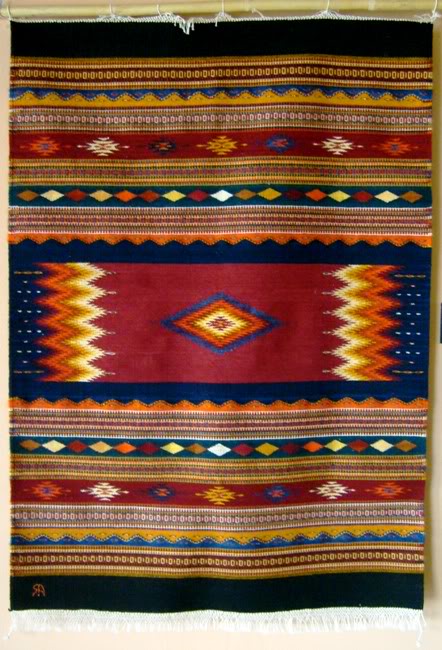 Note the detail in the photo below. This one is a normal-sized rug for a floor -- maybe 4' x 3'. 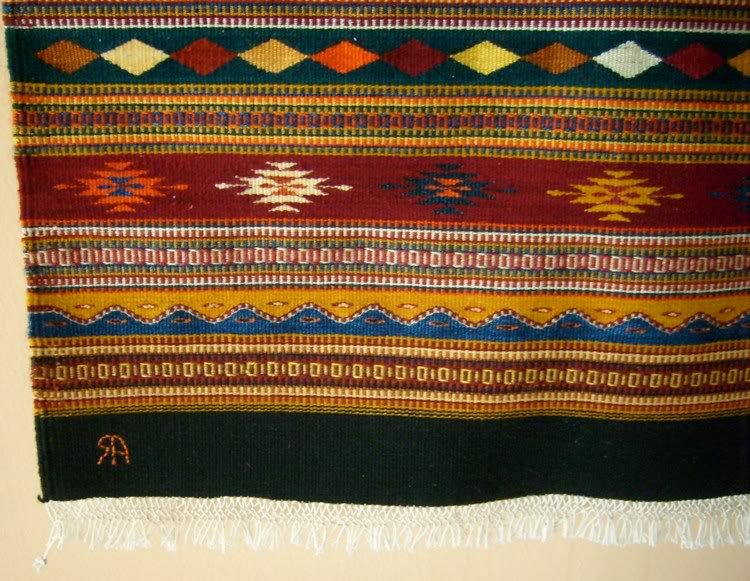 |
|
|
|
Post by hwinpp on Apr 20, 2010 7:01:57 GMT
I'm always surprised by the 'cosmopolitanism' you show in your pics. I keep on thinking you live out in the sticks then you post pictures of a modern museum. Seems like the area offers a lot more than tequila and agave plants.
|
|
|
|
Post by bjd on Apr 20, 2010 12:55:46 GMT
Lovely pictures, Bixa. I'm always impressed by the wonderful mixtures of bright colours in folk art. And I really like those black pots -- simple and elegant in form.
In Ecuador too I visited a couple of museums and was really impressed by their layout and quality, even in small towns. It's obviously the same case in Mexico.
|
|
|
|
Post by Deleted on Apr 20, 2010 20:02:18 GMT
I love empty museums... and feel sorry for them at the same time.
|
|
|
|
Post by bixaorellana on Apr 20, 2010 20:24:36 GMT
I'm always surprised by the 'cosmopolitanism' you show in your pics. I keep on thinking you live out in the sticks then you post pictures of a modern museum. Seems like the area offers a lot more than tequila and agave plants. HW, you are not wrong in thinking that I live out in the sticks, nor that much of the area around Oaxaca is fairly primitive by first world standards. The road to my house is horrible, for instance, even though it's part of the municipality of Xoxocotlán, which encompasses two modern shopping malls, some fancy subdivisions, and the international airport. However, the history and the culture of the valleys of Oaxaca is so rich it's enormously interesting here. (that link concentrates on the Zapotecs. For a fuller view of the areas history, please look at this.) Incidentally, I really appreciate these comments and questions. They make me dig deeper for answers and learn more. I have just amended my previous post, for instance, having learned more about the construction of the museum. All of the craft villages are out in the sticks, but often the sticks are practically stuck on to the city of Oaxaca, which is the state capital. I live less than 10 miles from the center of Oaxaca, for instance, and there is ample public transportation to all of the outlying areas. Lovely pictures, Bixa. I'm always impressed by the wonderful mixtures of bright colours in folk art. And I really like those black pots -- simple and elegant in form. In Ecuador too I visited a couple of museums and was really impressed by their layout and quality, even in small towns. It's obviously the same case in Mexico. Aren't they lovely? I think the blackness and the low gloss make them appropriate for any setting. No one has asked, but this is very affordable art. In the first three photos of Reply #1, you're looking at items that cost between five & ten dollars. About the quality of small town museums in Ecuador -- I wonder if they use the same time-honored system of tequio that is prevalent here. (read this) I love empty museums... and feel sorry for them at the same time. Well, I did visit fairly late on a Thursday afternoon, so I doubt that was indicative of normal usage. San Bartolo gets lots of tourist visits, including busloads, because of its black pottery. |
|
|
|
Post by bixaorellana on Apr 20, 2010 22:05:08 GMT
Wood carving is well represented. This wonderful mask is by Margarito Melchor Fuentes of San Martín Tilcajete. 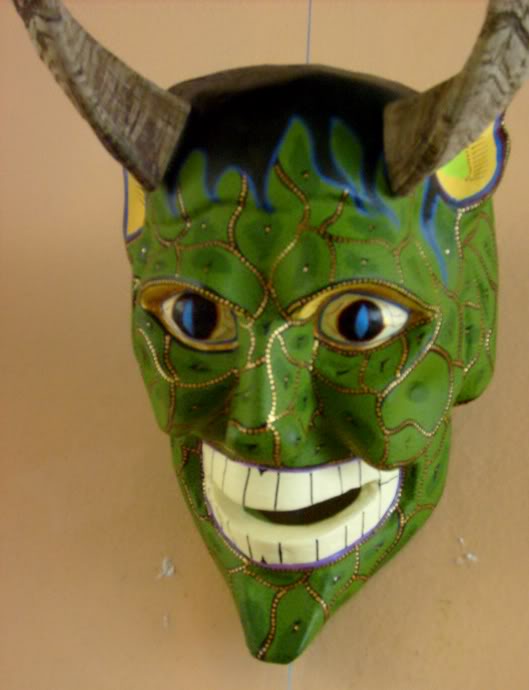 This sculpture is by Artemio Raymundo Ibáñez Ramirez, who is originally from San Antonio Arrazola. It's called Monte Albán and its Demons. 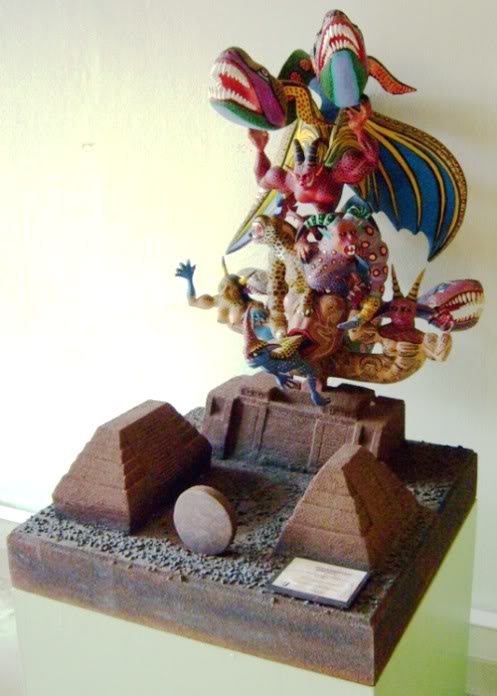 A close-up showing the incredible detail and expression: 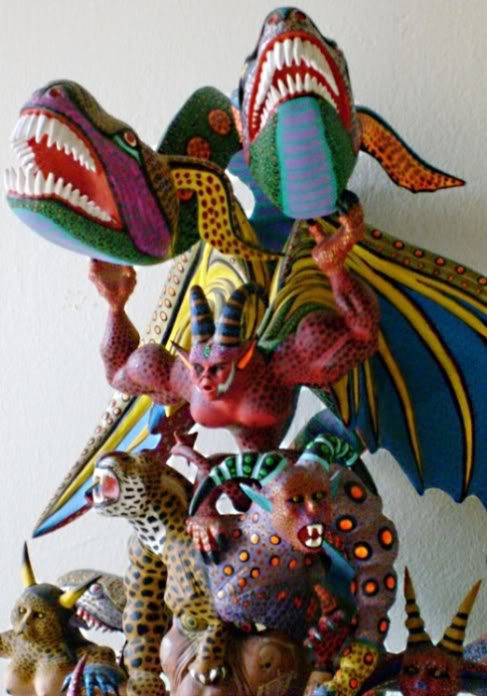 The young couple who created the masterful piece below are internationally known for their beautiful and sensitive work. I am fortunate in having a friend who's collected some of it. I've inspected her pieces innumerable times, but am always struck anew by their colors and intricate detail. The artists are Jácobo Angeles Ojeda and his wife María del Carmen Mendoza. I visited their workshop with my friend once when she commissioned a piece, and met María del Carmen Mendoza. What a lovely, gracious person she is! 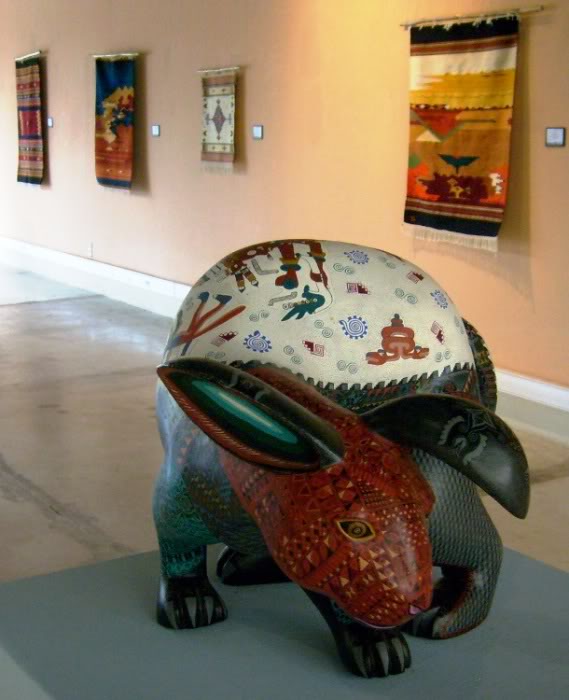  I did the best I could with those two photos, but for the next best thing to being there, you need to click here. When you arrive at the page, mouse over the picture and click again. You'll be able to peruse an extreme close-up of the head area, & will doubt the evidence of your own eyes. This page has more detailed information about the artist couple, along with some great pictures. |
|
|
|
Post by bixaorellana on Apr 20, 2010 22:58:39 GMT
Well, I'm flagging and can always come visit another day. There are some good views up here. 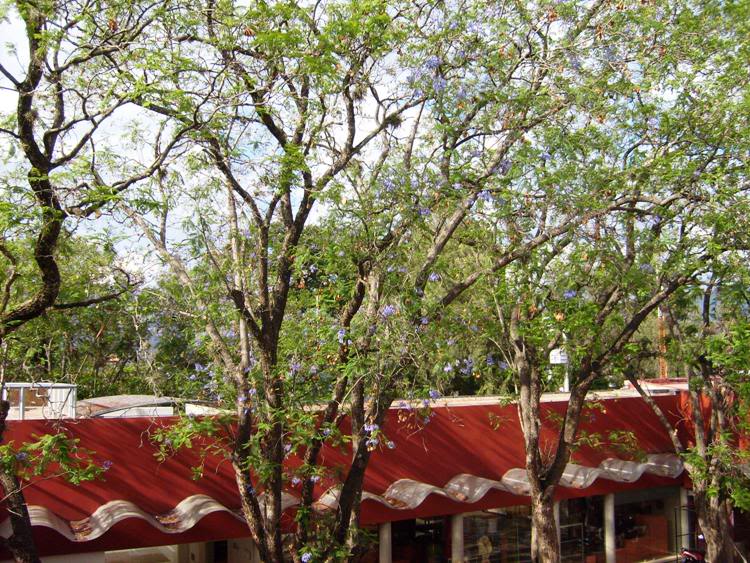  Looking west from the large patio formed by the roof of the exhibition hall below. 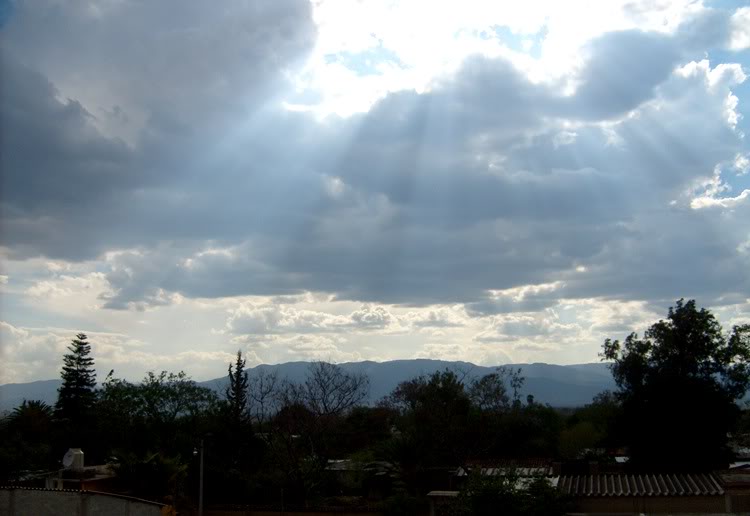 Another view of the church as I descend the ramp. 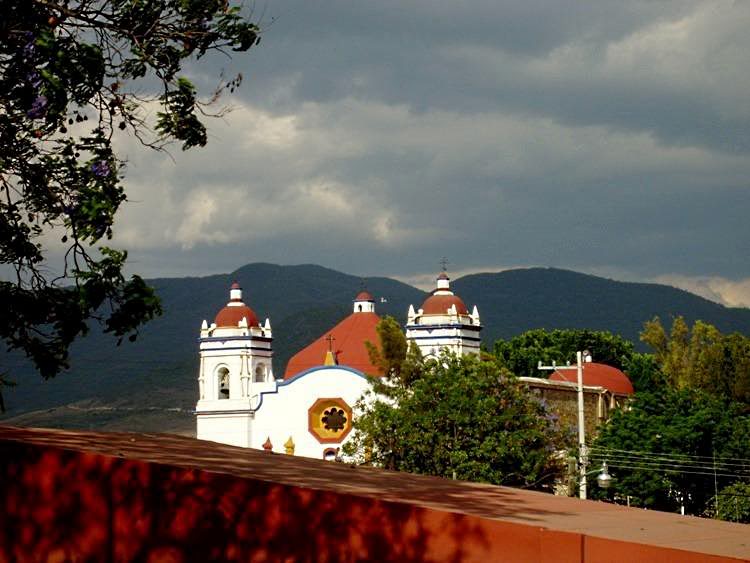 A quick turn around the town square and over to the small crafts market is further inducement to return and visit another day. 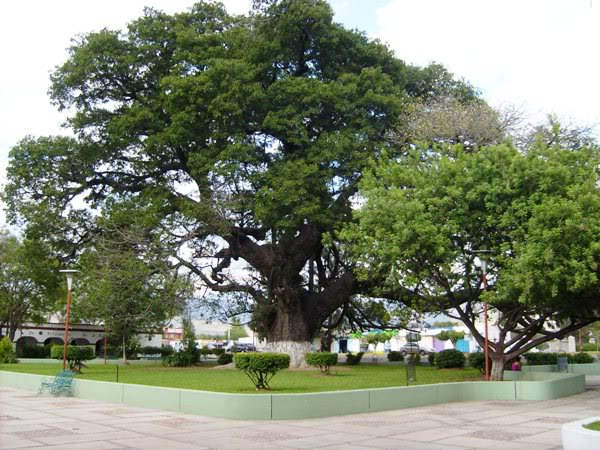
Time to rattle on home --
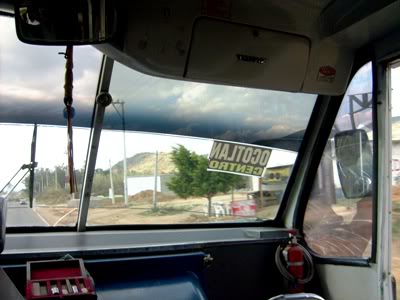 If you enjoyed this visit and would like to see a little more, check out the museum's official site. English option on the upper right. You can access the FOFA (Friends of Oaxaca Folk Art) website from the museum site above. This site is all in Spanish, but has the best interior views of the museum I've found, plus pictures of objects from previous exhibitions. |
|
|
|
Post by gertie on Apr 21, 2010 5:21:33 GMT
That critter is amazing, I guess it is a hare? I love the little smile-y triangle faces on the top of the head! Thank you so much, bixa!
|
|
|
|
Post by bixaorellana on Apr 21, 2010 16:46:16 GMT
I am so glad you enjoyed it, Gertie. And thank you for taking the time to tell me that you did. This kind of presentation is an interesting exercise for the person making it. I really learned so much, since I had to look stuff up. Also, I got valuable pointers about thinking ahead (why didn't I think to photograph all the cards next to the pieces of artwork I snapped?  ). But the best part is in selecting what to photograph and what to present -- how to simultaneously please oneself and figure out what might be of interest to other people. About the Angeles/Mendoza figure -- I think you're right that it's a rabbit. I wish you could see one of their pieces in the round. Not only do they work on a design level, both in shape and in detail, but they really have a presence and life to them. Besides the recognizable animal sculptures, the couple also create figures known as naguales. These will have both animal and human features and are most striking. Here one is being demonstrated. The other word for nahual being used is tonal. |
|
|
|
Post by Deleted on Apr 21, 2010 19:08:19 GMT
The items in #25 are beyond wonderful, even when you can't figure out if they would go well on the mantlepiece (not to mention the fact that I don't even have a mantlepiece).
|
|